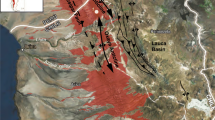Abstract
Anisotropy of magnetic susceptibility (AMS) and characteristic remanence were measured for 45 sites in the 0.76 Ma Bishop tuff, eastern California. Thirty-three sites were sampled in three stratigraphic sections, two in Owens gorge south of Long Valley caldera, and the third in the Adobe lobe north of Long Valley. The remaining 12 sites are widely distributed, but of limited stratigraphic extent. Weakly indurated, highly porous to dense, welded ash-flow tuffs were sampled. Saturation magnetization vs temperature experiments indicate two principal iron oxide phases: low Ti magnetites with 525–570 °C Curie temperatures, and maghemite with 610°–640 °C Curie temperatures. AF demagnetization spectra of isothermal remanent magnetizations are indicative of magnetite/maghemite predominantly in the multidomain to pseudo-single domain size ranges. Remeasurement of AMS after application of saturating direct fields indicates that randomly oriented single-domain grains are also present. The degree of anisotropy is only a few percent, typical of tuffs. The AMS ellipsoids are oblate with Kmin axes normal to subhorizontal foliation and Kmax axes regionally aligned with published source vents. For 12 of 16 locality means, Kmax axes plunge sourceward, confirming previous observations regarding flow sense. Topographic control on flow emplacement is indicated by the distribution of tuff deposits and by flow directions inferred from Kmax axes. Deposition east of the Benton range occurred by flow around the south end of the range and through two gaps (Benton notch and Chidago gap). Flow down Mammoth pass of the Sierra Nevada is also evident. At least some of the Adobe lobe in the northeast flowed around the west end of Glass mountain. Eastward flow directions in the upper Owens gorge and southeast directions in the lower Owens gorge are parallel to the present canyon, suggesting that the present drainage has been established along the pre-Bishop paleodrainage. Characteristic remanence directions from 45 sites (267 samples) yield an overall mean of D=348°, I=53° for the Bishop tuff. A correlation is found in two of the three profiles between density and remanence inclination. A mean remanence direction based on 13 localities together with data from uncompacted xenoliths and data from the ash-fall tuff at Lake Tecopa is: D=353°, I=54°, k=172, α95=2.9°, N=15.
Similar content being viewed by others
Author information
Authors and Affiliations
Rights and permissions
About this article
Cite this article
Palmer, H., MacDonald, W., Gromme, C. et al. Magnetic properties and emplacement of the Bishop tuff, California. Bull Volcanol 58, 101–116 (1996). https://doi.org/10.1007/s004450050129
Received:
Accepted:
Published:
Issue Date:
DOI: https://doi.org/10.1007/s004450050129



